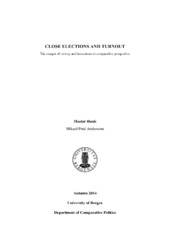| dc.description.abstract | More people decide to vote when the race is close than when it is not. This is arguably the most consistent finding in aggregate-level research on turnout. However, studies in recent years using multilevel analysis consistently tend not to find any such link at the individual-level. My motivation for this thesis was to uncover the reason for this puzzling inconsistency. I argue that closeness indeed can affects the decision to vote, but that this effect is contingent and indirect. The changes in aggregate turnout is the result of different mechanisms affecting different people in different situations. In this endeavor, instead of asking if closeness of elections affects the decision to vote, I therefore ask, for whom might it do so? I use several theories from across the social sciences, and propose five different hypotheses for whom closeness might count and why that is. I hypothesize that (i) although closeness of election only affect those without a habit of voting; (ii) it fuels cognitive engagement for those that are interested in the election; and (iii) it fuels interest in the election for those who are educated or (iv) feel close to a particular party. In general, it should (v) affect the decision to vote indirectly through interest in the election. To test these hypotheses I use multilevel regression models and mediation analysis on cross-national survey data from the Comparative Study of Electoral System. I calculate closeness of election in a novel way so that it is comparable across different electoral systems. The complete data set includes 35,913 respondents from legislative elections in 26 countries between 2006 and 2011. Although too inconclusive for hypothesis v, the empirical analysis lend clear support for hypotheses i-iv. Indeed, the regression models indicate no statistically significant relationship when looking at the mean; only when controlling for the right things and looking in the right place do we see how closeness may help shape political behavior. The results clearly supports the notion that closeness of elections can affect the decision to vote, for some people in some situations. This contributes to an empirical foundation and understanding for the role of closeness of election in shaping turnout. It also highlights how combining different theoretical approaches can help uncover the more complex ways in which different factors interact in shaping political participation. | en_US |
